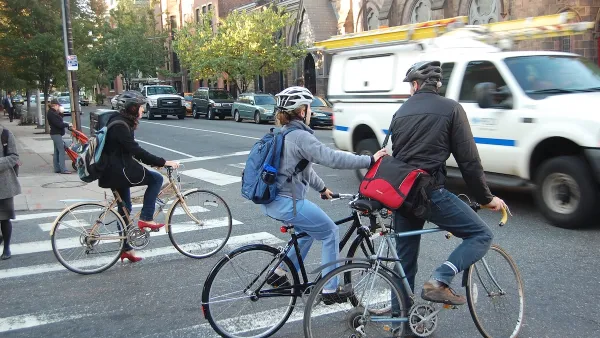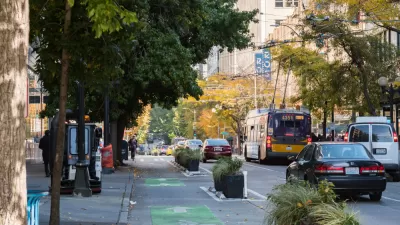The needs that drive complete streets policy are as unique as the communities they have taken root, but effective complete streets programs do share a few common traits.

"The concept of complete streets places the same priority on pedestrians, bicyclists and public transport users as on motorists," according to an article by Anna Bray Sharpin, Ben Welle, and Nikita Luke for TheCityFix that provides a guide to the core components of complete streets in the many global examples of complete streets programs. There are a lot of examples to choose from, according to the article, as "more than 1,140 agencies at the local, regional, and state levels have adopted complete streets policies in the United States, totalling more than 1,200 policies nationwide." And the idea has been translated around the world. "They are the so-called calles completas in Mexico, ruas completas in Brazil, and “streets for all” in India."
The post lists eight key elements to complete streets, listed below but detailed with more specificity in the article:
- An Active Streetscape
- Pedestrian-Scale Lighting
- Green Infrastructure
- Street Furniture
- Bicycle Facilities
- Signage
- Accessibility for All
- Surface Types
FULL STORY: What Makes a Complete Street? A Brief Guide

Planetizen Federal Action Tracker
A weekly monitor of how Trump’s orders and actions are impacting planners and planning in America.

DARTSpace Platform Streamlines Dallas TOD Application Process
The Dallas transit agency hopes a shorter permitting timeline will boost transit-oriented development around rail stations.

Congressman Proposes Bill to Rename DC Metro “Trump Train”
The Make Autorail Great Again Act would withhold federal funding to the system until the Washington Metropolitan Area Transit Authority (WMATA), rebrands as the Washington Metropolitan Authority for Greater Access (WMAGA).

Supreme Court Ruling in Pipeline Case Guts Federal Environmental Law
The decision limits the scope of a federal law that mandates extensive environmental impact reviews of energy, infrastructure, and transportation projects.

Texas State Bills to Defund Dallas Transit Die
DART would have seen a 30% service cut, $230M annual losses had the bills survived.

Bikeshare for the Win: Team Pedals to London Cricket Match, Beats Rivals Stuck in Traffic
While their opponents sat in gridlock, England's national cricket team hopped Lime bikes, riding to a 3-0 victory.
Urban Design for Planners 1: Software Tools
This six-course series explores essential urban design concepts using open source software and equips planners with the tools they need to participate fully in the urban design process.
Planning for Universal Design
Learn the tools for implementing Universal Design in planning regulations.
Roanoke Valley-Alleghany Regional Commission
City of Mt Shasta
City of Camden Redevelopment Agency
City of Astoria
Transportation Research & Education Center (TREC) at Portland State University
US High Speed Rail Association
City of Camden Redevelopment Agency
Municipality of Princeton (NJ)





























